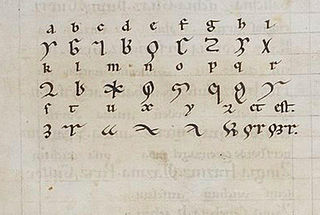| Lingua ignota | |
|---|---|
 St. Hildegard's 23 litterae ignotae. | |
| Pronunciation | [ˈlinɡʷa iŋˈnoːta] |
| Created by | Hildegard of Bingen |
| Purpose | Constructed language
|
| Language codes | |
| ISO 639-3 | None (mis) |
| Glottolog | None |
| IETF | art-x-ignota |
| Litterae ignotae | |
|---|---|
| Script type | Alphabet
|
| Creator | Hildegard von Bingen |
Time period | 12th century |
| Direction | Left-to-right |
| Language | Lingua ignota |
| Part of a series on |
| Christian mysticism |
|---|
 |
A lingua ignota (Latin for "unknown language") was described by the 12th-century abbess Hildegard of Bingen, who apparently used it for mystical purposes. It consists of vocabulary with no known grammar; the only known text is individual words embedded in Latin. To write it, Hildegard used an alphabet of 23 letters denominated litterae ignotae (Latin for "unknown letters").[1]
- ^ Bingensis, Hildegardis (1175–1190). Riesencodex. pp. 934, 464v. Archived from the original on 2014-12-20. Retrieved 2014-08-26.